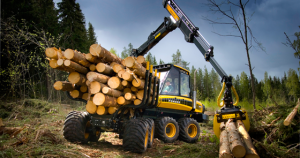World demand for forestry equipment including purpose-built and converted machinery is forecast to climb 4.5% annually to US$9.3 billion in 2019. Source: PR Wire
This will represent a moderation from the 2009-2014 pace of increase, a period during which market gains were bolstered by a rebound in roundwood production from lows posted during the 2009 global recession, as well as by the institution of new engine emissions standards in the European Union (EU) and US.
Sales advances will be driven in part by the ongoing mechanization of forestry operations in developing regions.
In mature, developed world markets, an acceleration in economic growth and a generally favorable fixed investment climate will help boost demand as forestry companies seek to reduce their operating costs and increase output through the use of technologically sophisticated, high-value machinery.
Additional government regulatory actions are also likely to bolster sales of new, higher priced units engineered to meet these requirements.
In deflated, constant dollars, forestry equipment demand will rise at a 2.3% annual rate through 2019, marginally faster than expected growth in industrial roundwood output.
US to record largest increases in equipment sales
The US and Canada together represent the largest geographic market for forestry equipment, accounting for one-third of global product demand in 2014.
Western Europe is the second largest market, with a 22% share of all equipment sales in 2014, followed by the Asia/Pacific region, Eastern Europe, Latin America, and the Africa/Mideast region.
The US will record the largest increases of any forestry equipment market in dollar terms through 2019, supported by a pickup in economic activity and construction expenditures, a healthy capital spending environment, and growth in roundwood output.
Brazil, a considerably smaller but still sizable forestry machinery market, will register larger increases in percentage terms, expected to average 6.5% per year through 2019.
A number of smaller national markets including New Zealand, Poland, Finland, and Indonesia will also post above average demand gains.
On a regional basis, Latin America and Eastern Europe will record the fastest sales increases in percentage terms, and Western Europe will register the weakest market advances, restricted by the already high mechanization rates in the largest national forestry machinery markets in this region.
However, lower mechanization levels in parts of Western Europe will provide some impetus to growth in product demand through 2019.
Harvesters, forwarders to be fastest growing products
Felling equipment accounts for the largest share of world forestry equipment sales, followed by separately sold parts and attachments, and extracting equipment.
On-site processing equipment and all other forestry equipment account for remaining demand.
The fastest market gains will be posted by harvesters and forwarders, supported by increased use of cut-to-length harvesting methods relative to tree-length and whole-tree systems.
Sales of on-site chippers and grinders will also expand at a comparatively fast pace, spurred by rising demand for wood pellets as a power plant feedstock, most notably in the EU.
Harvesting and other cutting heads will also grow at an above average rate, fueled by both heightened roundwood output and growing usage of mechanized harvesting and on-site processing equipment in developing areas.
Study coverage
This upcoming Freedonia industry study, World Forestry Equipment presents historical supply and demand data (2004, 2009, and 2014) plus forecasts (2019 and 2024) by product, world region, and for 14 major national markets.
The study also considers market environment factors, details the industry structure, evaluates company market share and profiles global industry player






